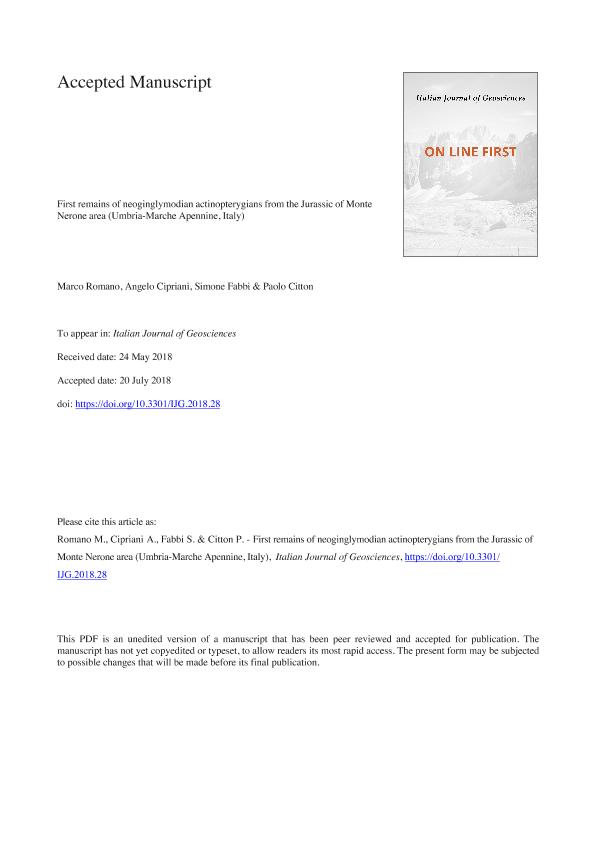Artículo
First remains of neoginglymodian actinopterygians from the Jurassic of Monte Nerone area (Umbria-Marche Apennine, Italy)
Fecha de publicación:
02/2019
Editorial:
Società Geologica Italiana
Revista:
Italian Journal of Geosciences
ISSN:
2038-1719
e-ISSN:
2038-1727
Idioma:
Inglés
Tipo de recurso:
Artículo publicado
Clasificación temática:
Resumen
Since the early nineteenth century, the structural high of Mt. Nerone in the Umbria-Marche-Sabina Domain (UMS - Central/ Northern Apennines, Italy) attracted scholars from all over Europe due to the wealth of fossil fauna preserved in a well-exposed Mesozoic sedimentary succession. Several geo-palaeontological studies were focused on the abundant and diverse invertebrate fauna, whereas contributions dealing with Mesozoic vertebrates were to date virtually lacking. Recently, the first material referable to hybodont sharks, consisting of an articulated crushing dentition, was described from the area and referred to Asteracanthus cf. A. magnus. In this contribution, we report the first evidence of ginglymodian actinopterygians from the Upper Jurassic of Mt. Nerone. The material is represented by seven highly tritorial isolated teeth collected from three classic fossiliferous localities of the area (i.e. Pian del Sasso, Fosso Pisciarello, I Ranchi). The general morphology of the material under study allow us to conservatively refer the teeth to the Neoginglymodi, a clade formed by Lepisosteiformes and Semionotiformes. The occurrence of durophagous organisms, to date represented by hybodont sharks and ginglymodian fishes, reveals interesting palaeoecological scenarios characterizing the pelagic carbonate platform-basin system of Mt. Nerone, which were most likely triggered by large-scale geodynamic processes. The complex submarine palaeotopography, inheritance of the Western Tethys Early Jurassic rifting, aroused the establishment of new infaunal and epifaunal communities opening up unexplored trophic niches for durophagous predators. The particular geodynamic setting of the UMS Domain, consisting of predominantly interconnected structural highs and lows, and the relative evolution of a diverse invertebrate fauna characterized by terebratulid, ostreids, limids, brachiopods, crustaceans, and gastropods, attracted both hybodontids and durophagous ginglymodians in the Tethyan realm, influencing their dispersal during the Late Jurassic.
Archivos asociados
Licencia
Identificadores
Colecciones
Articulos(IIPG)
Articulos de INSTITUTO DE INVESTIGACION EN PALEOBIOLOGIA Y GEOLOGIA
Articulos de INSTITUTO DE INVESTIGACION EN PALEOBIOLOGIA Y GEOLOGIA
Citación
Romano, Marco; Cipriani, Angelo; Fabbi, Simone; Citton, Paolo; First remains of neoginglymodian actinopterygians from the Jurassic of Monte Nerone area (Umbria-Marche Apennine, Italy); Società Geologica Italiana; Italian Journal of Geosciences; 138; 1; 2-2019; 88-102
Compartir
Altmétricas




